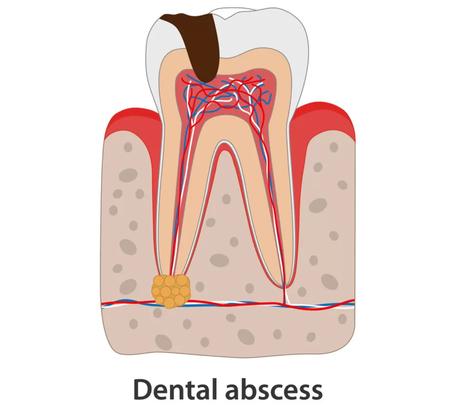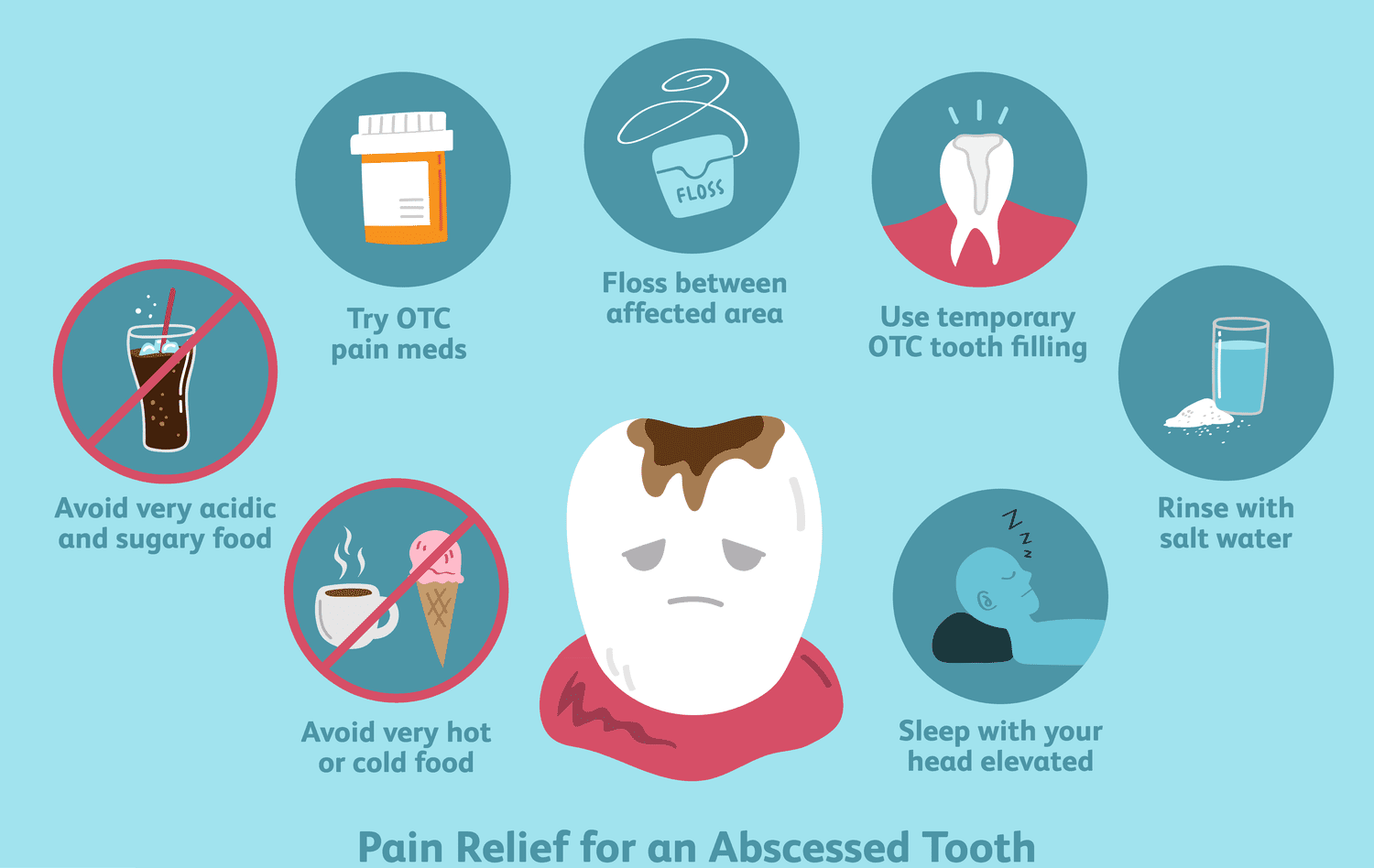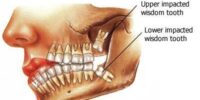What is an abscessed tooth?

An abscessed tooth is a serious dental condition that occurs when a tooth becomes infected. The infection is typically caused by bacteria that enter the tooth through a cavity or a crack in the tooth.
Abscessed tooth types
There are two main types of abscessed teeth: periapical abscesses and periodontal abscesses.
- Periapical abscess: This type of abscess occurs at the tip of the root of a tooth and is usually caused by a bacterial infection that has spread from the inside of the tooth. The infection can cause damage to the tooth’s pulp (the tissue inside the tooth that contains nerves and blood vessels) and can spread to the surrounding bone.
- Periodontal abscess: This type of abscess occurs in the gum tissue surrounding a tooth and is usually caused by a bacterial infection that has spread from the gum line. Periodontal abscesses are often associated with gum disease, which is caused by the accumulation of bacteria and plaque on the teeth.
Both types of abscessed teeth can cause serious health problems if left untreated, and it is important to seek treatment from a dentist as soon as possible if you suspect that you have an abscessed tooth.
Abscessed tooth symptoms
Symptoms of an abscessed tooth may include:
- severe toothache,
- swelling in the gum near the affected tooth,
- fever, and swollen lymph nodes.
If left untreated, an abscessed tooth can cause serious complications, such as the spread of the infection to other parts of the body or the development of a fistula (a small channel that forms between the infected tooth and the skin).
Abscessed tooth pain relief
It is important to note that these pain relief methods are only temporary and do not address the underlying cause of the pain. To fully resolve the pain and treat the abscessed tooth, it is necessary to see a dentist and receive appropriate treatment.
There are several options for relieving the pain associated with an abscessed tooth:
- Over-the-counter pain medication: Non-steroidal anti-inflammatory drugs (NSAIDs) such as ibuprofen and acetaminophen can help to reduce inflammation and relieve pain.
- Prescription pain medication: If the pain is severe, your dentist may prescribe a stronger pain medication, such as a narcotic, to help manage your discomfort.
- Cold compress: Applying a cold compress to the outside of your cheek or jaw can help to reduce swelling and numb the area, providing temporary relief from pain.
- Saltwater rinse: Rinsing your mouth with warm saltwater can help to reduce inflammation and kill bacteria, which may provide some relief from pain.
- Clove oil: Applying clove oil to the affected tooth can help to numb the area and reduce pain.

Treatments
Treatment for an abscessed tooth typically involves a combination of antibiotics to clear the infection and a procedure to drain the abscess. This may involve a root canal, in which the infected tissue inside the tooth is removed and the inside of the tooth is cleaned and sealed, or the extraction of the tooth if it is too damaged to be saved.
Possible treatment options for an abscessed tooth may include:
- Root canal: This procedure involves removing the infected tissue inside the tooth and cleaning and sealing the inside of the tooth. A root canal can help to save a tooth that is damaged by an abscess and can prevent the infection from spreading to other parts of the body.
- Extraction: If a tooth is too damaged to be saved, it may need to be extracted (removed). This can be done through a simple extraction, in which the tooth is pulled directly out of the socket, or through a surgical extraction, in which the tooth is removed through an incision in the gum tissue.
- Antibiotics: Antibiotics can be used to treat the infection and help to prevent the spread of the infection to other parts of the body.
- Pain management: Pain medication may be used to manage the discomfort associated with an abscessed tooth.
Abscessed tooth vs gingival abscess
An abscessed tooth and a gingival abscess are two different types of dental conditions, although they can be related.
A gingival abscess, also known as a gum abscess, is a type of abscess that occurs in the gum tissue surrounding a tooth. It is usually caused by a bacterial infection that has spread from the gum line. A gingival abscess can cause symptoms such as swelling and pain in the gum tissue, and it may also cause a bad taste in the mouth or difficulty swallowing.
Gingival abscesses are often associated with gum disease, which is caused by the accumulation of bacteria and plaque on the teeth. In some cases, a gingival abscess may be a sign of an underlying abscessed tooth. Therefore, it is important to see a dentist if you suspect that you have a gingival abscess, as the underlying cause may be an abscessed tooth that requires treatment.
Abscessed tooth prevention
To prevent an abscessed tooth, it is important to practice good oral hygiene, including brushing and flossing daily, and to visit the dentist regularly for cleanings and checkups. If you have any symptoms of an abscessed tooth, it is important to see a dentist as soon as possible to avoid serious complications.
Some specific prevention methods include:
- Brush your teeth twice a day: Brushing your teeth with fluoride toothpaste removes plaque and bacteria from your teeth, helping to prevent cavities and gum disease.
- Floss daily: Flossing removes plaque and food particles from between your teeth, helping to prevent gum disease and tooth decay.
- Use mouthwash: Mouthwash can help to kill bacteria and freshen your breath.
- Avoid sugary and acidic foods: These types of foods can increase your risk of cavities and gum disease.
- Drink plenty of water: Staying hydrated can help to rinse bacteria and food particles from your mouth.
- Visit the dentist regularly: Regular dental checkups and cleanings can help to identify and treat dental problems in the early stages, before they become more serious.
Key takeaways
- An abscessed tooth is a serious dental condition that occurs when a tooth becomes infected.
- Symptoms of an abscessed tooth may include severe toothache, swelling in the gum near the affected tooth, fever, and swollen lymph nodes.
- Treatment for an abscessed tooth may involve a root canal, extraction, antibiotics, or a combination of these methods.
- To prevent an abscessed tooth, it is important to practice good oral hygiene, avoid sugary and acidic foods, and visit the dentist regularly for cleanings and checkups.
- Prompt treatment of an abscessed tooth is important to prevent serious complications and to preserve the affected tooth.
Conclusion
An abscessed tooth is a serious dental problem that requires prompt treatment to prevent serious complications and to preserve the affected tooth. By practicing good oral hygiene and visiting the dentist regularly, you can help to prevent an abscessed tooth and maintain good oral health.









